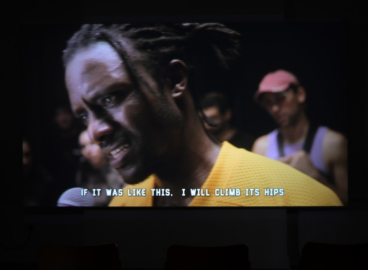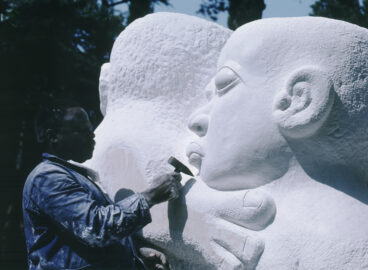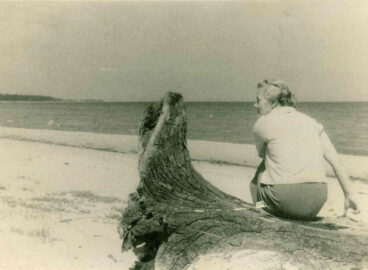From Matter to Data: Ecology of Infrastructures presents a selection of 15 films and video works that will be made available in three parts from July 29 till September 9. In this third selection, available for viewing from August 26 to September 9, artists reflect on the environmental damage caused by socialist modernization and capitalist industrialization.
Past’s Futures: Anthropocene or Capitalocene?
The forecasts for the near future of our planet are bleak. We have entered a new geological epoch, according to which human impact has damaged the Earth’s biological systems to the point that mass extinction is now a real possibility. Humanity—and the rest of life with it—is now on the threshold of an ecological collapse that, as scientists state, could result in 75% of Earth’s species becoming extinct in the next 200 years. This new geological epoch has been commonly termed the Anthropocene. However, the Capitalocene—an alternative term to refer to deleterious human activities—has also been proposed by Jason W. Moore.1Moore, Jason W. (ed.) Anthropocene or Capitalocene? Nature, History, and the Crisis of Capitalism, PM Press, 2016, p. 6-9 Defining an inseparability between capital, anthropocentric power, and nature, the Capitalocene has triggered global conversations between scholars, activists and artists who have reached a collective agreement: climate change and its effects are not just the outcome of abstract processes, they are consequences of the world’s capitalist functions. The ecological crisis is “capitalogenic”, as Moore points out in his analysis of the last few hundred years of environmental issues.2Moore, Jason W., “World Accumulation & Planetary Life, or, Why Capitalism Will Not Survive Until the ‘Last Tree is Cut”, in: https://www.perc.org.uk/project_posts/world-accumulation-planetary-life-capitalism-will-not-survive-last-tree-cut/, 20th December 2017 However, thinking within the post-socialist era, more questions arise. The annexation of Eastern Europe to the Soviet sphere of influence after World War II has reshaped the face of the land, changed the function of natural environments and caused environmental crises. As philosopher and filmmaker Daniel Ross points out, the communist vision of technological progress, industrialization and urbanization was highly entropic and stands as an illustration of how human dreams can become nightmares.3Ross, Daniel. “Moving Images of the Anthropocene: Rethinking Cinema Beyond Anthropology Daniel Ross”, Screening the Past, 2016 Thus, not surprisingly, in many countries under Soviet rule, ecological thought emerges intertwined with nationalist and anti-governmental sentiments. This having been said, it seems fair to ask, can we apply the term Capitalocene to describe the ecological damage exerted by communist regimes?
In the post-1989 period, video artists from post-socialist countries started to reflect on the environmental legacy of socialist regimes whilst also addressing degradation caused by neoliberalism. The final part of this screening series provides a context-specific look at how the Anthropocene and Capitalocene apply in the region. The artists and filmmakers presented in this screening reveal how moving image art from 1989 to the present registers changing attitudes toward the environment and exposes environmental damage caused by both socialist modernization and capitalist industrialization. The films presented here engage with ecological issues related to the times that now mark the failed dreams of East-Central European socialism. The futures assigned to the world in the socialist past are not the futures of the present.
Untitled (Time and Space) by Krzysztof Maniak

The return to nature was one of the eco-critical strategies available to the artists during the socialist times. Re-interpreting this tradition, Krzysztof Maniak’s film Untitled (Time and Space) documents actions performed in the vicinity of Tuchów, a Polish backwater. The simple gestures and actions, performed by the artist in the absence of an audience, include stroking moss, tree bark or snow, climbing trees, and estimating the distance between two trees. These actions are linked to the four seasons.
Bambi in Chernobyl by Angelika Markul

Chernobyl has been a desolate land since the nuclear disaster of 1986. Since then, nature seems to have regained its footing: fauna and flora have developed on the site, slowly invading the ruins of a world abandoned by humans. Angelika Markul’s Bambi in Chernobyl, a film based on footage of the artist’s expedition to the exclusion zone, explores a return to nature that is no longer pristine. As the artist has pointed out, the work is supposed to function like a sculpture, not just a projection. The scenography is important as the elements from the film are replicated in wax, resembling parts of a building from Chernobyl. In this structural film, the past and the future, the East and the West, dreams and reality collide in a lengthy shot of the scene of the nuclear catastrophe, extending the perspective of the devastated and toxic landscape from right to left, and from one end to the other. Markul transforms the image of post-disaster into a world suspended between reality and fiction that awakens childish fears. The film’s score, composed by Franck Krawczyk, was inspired by Bambi, a Disney classic animation movie. Ironically, it contributes to the oeuvre’s post-catastrophic imagery which is as familiar as it is uncanny.
Aral. Fishing in an Invisible Sea by Saodat Ismailova

Chernobyl is just one of many sites of ecological disasters that bear environmental memories of the socialist epoch. The Aral Sea is another. Fifty years ago, located on the border between Kazakhstan and Uzbekistan in Central Asia, the Aral Sea was considered to be the fourth largest lake in the world. Now, it has almost completely vanished. The desiccation of the Aral Sea started in the early 1960s with the expansion of the cotton industry and Soviet irrigation projects. These changes caused profound ecological damage, including the destruction of native fish species, degradation of biotic communities, and climate change which has affected the former shoreline. The disappearance of the Aral Sea represents an ecological disaster of monumental proportions for both the region’s ecosystems and its human inhabitants. A documentary film by Saodat Ismailova, Aral. Fishing in an Invisible Sea, tells the story of three generations of fishermen in the area around the Aral Sea. The work documents the everyday struggle to survive in one of the harshest places on the planet, emphasizing the disastrous aftermath of human expansionist ambitions. By tracing the invisible and lasting effects of what is considered to be one of the largest human-caused ecological disasters on the planet, the film questions the failed futures of its recent communist past.
The Most Beautiful Catastrophe by APART Collective

Another film dealing with the overexploitation and extraction of natural resources is The Most Beautiful Catastrophe by APART Collective. The film, shot in the region of upper Nitra, examines the industry of coal mining and its impact on the living environments. The extraction of coal, initiated during the communist era, still remains one of the main industries in Slovakia despite the growing threat of climate change. The film specifically focuses on the Kosovsko-Laskár wetlands that are located in the Central-Western Slovakia. These wetlands emerged as a by-product of the underground extraction of coal, and are probably the first example of a new landscape to emerge in Slovakia. Mining has changed the territory: large sinkholes have been created, affecting both housing and the natural environment. This environmental impact has forced people to move, forming an unusual habitat as nature finds its balance. But after several years, the situation has worsened. A crisis at the still-operational mine caused water to be discharged from its flooded tunnels up to the surface. As miners began to pump this water into the nearby creek, their skin burned. This mixture, of ash and hydraulic emulsion, managed to kill all life in the creek. The film explores the impact of technological progress on global warming and raises the question of geopolitical writing with the planet, not only about the planet. Here, the past’s futures overlap with the future’s pasts.
Landslide by Oleksiy Radynski

Landslide by Oleksiy Radynski is a film about an attempt to build a radically different society. This experiment takes place in the former garage collective in the very center of Kyiv, in the area reclaimed by nature and its force. Landslides, degradation of urban politics and disintegration of social ties culminated in the abandonment of this place in the 1990s. In 2016, Radynski was among the counterculture artist collectives, musicians and avant-garde performers to re-occupy this place. The protagonists of the film touch upon the old debate between Anarchists and Marxists, of whether one should live one’s utopia right here and now, or create conditions for a better life in the future. A central narrative forms around a queer theater director who has fled the Eastern Ukraine to find refuge in Kyiv. The director rehearses a play that culminates in an improvised performance towards the end of the film. As the narrative of the director unfolds, a different group of inhabitants— an older generation of garage owners—is introduced, advocating a completely different view of the place’s pasts and its potential futures. Gravity, the force that triggers the landslide, becomes a metaphor for this short-lived meeting of urban nature, post-Soviet masculinity and queer performance.
This film program is organized by Inga Lāce and Lukas Brasiskis in collaboration with the Latvian Centre for Contemporary Art, Lithuanian Culture Institute and Lithuanian Cultural Attaché in New York, Consulate General of Estonia in New York, Polish Cultural Institute New York, and Consulate General of the Slovak Republic in New York. The third screening “Past’s Futures: Anthropocene or Capitalocene?” will be available from August 26 to September 9, 2020. You can read about the first screening here and second screening here.
- 1Moore, Jason W. (ed.) Anthropocene or Capitalocene? Nature, History, and the Crisis of Capitalism, PM Press, 2016, p. 6-9
- 2Moore, Jason W., “World Accumulation & Planetary Life, or, Why Capitalism Will Not Survive Until the ‘Last Tree is Cut”, in: https://www.perc.org.uk/project_posts/world-accumulation-planetary-life-capitalism-will-not-survive-last-tree-cut/, 20th December 2017
- 3Ross, Daniel. “Moving Images of the Anthropocene: Rethinking Cinema Beyond Anthropology Daniel Ross”, Screening the Past, 2016


